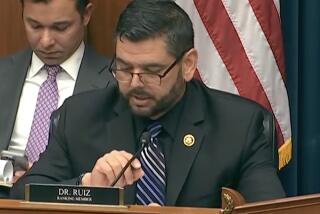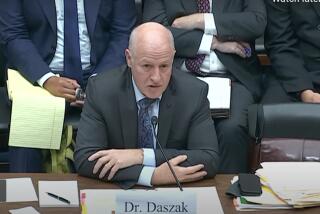Salk Institute Assembling Big Guns For War on AIDS
When Didier Trono first saw the elegant white buildings overlooking the Pacific in La Jolla, the Salk Institute looked to him like “the temple on the cliff.”
Now Trono has become one of the priests in that biology temple, the first in a core group that will look for basic knowledge that could help science outwit AIDS, the disease that killed the institute’s longtime president last year.
Trono has laid out the Center for AIDS Research--including an isolation lab where researchers can use the live AIDS virus--and moved into the search for research funds.
“The first year or so is a tough one, because you have a good chance of being turned down,” Trono said.
The Salk AIDS research unit is part of an expansion and redirection that has been under way since Frederic de Hoffmann retired in late 1988 as key fund-raiser and policy-maker after learning he had contracted AIDS from a contaminated blood transfusion. De Hoffmann gave the institute a very low public profile, from which it has been emerging over the past year.
Some of the continuing molecular biology, immunology and virology studies in other Salk departments will dovetail with the new unit, but the AIDS center represents Salk’s first effort to look at the specific, basic biology of the fatal disease, Trono said.
He was chosen for the job last summer after completing a post-doctoral fellowship in David Baltimore’s lab at the Whitehead Institute in Cambridge, Mass. But Trono couldn’t take the post formally until immigration difficulties were resolved in November.
A Swiss citizen, he needed a waiver of a rule requiring him to return to Switzerland for two years before taking a job in this country.
“We had to organize an incredibly heavy effort. It took like 25 letters from three or four Nobel Prize winners, the head of (the National Institute of Allergy and Infectious Diseases) and so on,” Trono said. “Which was totally out of proportion, if you realize the need in this country for people who do the kind of things that we’re doing. But that was the law.”
While waiting for the problem to be worked out, Trono and his wife and two children moved to Solana Beach, and he began informally consulting with Salk officials on how to set up the new labs.
Using space made available by the departure of Nobel laureate Roger Guillemin for the Whittier Institute in La Jolla, Trono had the researcher’s dream task of laying out the labs that he and two or three other principal investigators will share. (The other researchers have yet to be hired.)
“This building is a magic one, in that outside you have outer walls, but inside you can do whatever you want, because that’s the way Louis Kahn designed it,” Trono said. “You can move the walls, you can pull pipes down (from the ceiling) every two yards or so.”
The layout of a lab determines how work gets done, as well as what kind of interactions take place among researchers.
Like other Salk lab workers, the three to four researchers will share a vast open space. Trono also laid out the necessary machinery in ways to facilitate conversation.
“There is no better interaction than the ones you have at the centrifuge as you’re putting your tubes in, and the guy from the other group is also putting tubes in,” he said. “You get to exchange a lot in a very informal manner, and that’s the best way to interact.”
In one corner of the larger lab sits the “P-3,” science jargon for the room where special ventilation hoods, cleaned by multiple air filters, allow the live AIDS virus to be handled. Access is through key cards, and lab suits must be doffed and sterilized before leaving the room.
One of the room’s two glass walls overlooks the Torrey Pines Glider Port and the beach. “It’s the P-3 with the best view in the world,” Trono says with a laugh.
Trono, 34, received his medical degree in Geneva in 1981, and in 1985 took an infectious diseases fellowship at Massachusetts General Hospital in Boston. He went from there to the Whitehead Institute, where he became interested in the reproductive cycle of the AIDS virus.
By hiring Trono and not an older, more established researcher, the Salk is continuing its pattern of trying to nurture promising young scientists who have new ideas for basic research.
“This has been I think the secret of success of this institution, namely to try always to get to the young people and help them to grow,” said Salk president Renato Dulbecco. “Because, if we get really outstanding people then that’s the best thing we can do.”
Trono already has shown his ability to come up with novel ways of looking at old problems, said Bryan Cullen, a Duke University microbiologist whose work is similar to Trono’s.
“Trono has some really clever ideas, and I think that Salk has recruited one of the top young scientists available at this time. There’s no question about it,” he said.
Cullen and Trono are investigating what is called intracellular immunity--an idea for halting the AIDS virus in its dormant stage by teaching the body’s cells to make only crippled viruses. The AIDS virus, called human immunodeficiency virus or HIV, is a retrovirus. A retrovirus reproduces by inserting its genes into the genetic code of human cells, and is reproduced by them. Eventually, the infected cell dies.
Intracellular immunity bypasses the traditional method of protecting against a disease, that of stimulating the immune system to produce antibodies against a virus or bacterium. This is the approach being used by the institute’s founder, Jonas Salk, and others in AIDS vaccine trials that remain incomplete.
Many researchers doubt the approach will work, however, because the AIDS virus foils antibodies by attacking the antibody-making system and also by rapidly changing its outer envelope.
Trono’s idea is to use impostor genes to disrupt the cycle of HIV reproduction, so the particles budding out of infected cells would be defective and couldn’t spread to other cells.
“I asked, ‘Well, is it possible to throw into the cell some decoys that will make it so the virus will be unable to perform an essential (reproductive) step in its life cycle?’ ” Trono said. “Because, if that step doesn’t work, then the cell is some sort of a dead end for the virus.”
Trono’s target gene is gag, which occurs many times within the HIV genetic structure. Each copy directs the formation of a specific small protein, which later is strung together with others like it to enclose HIV’s genetic material.
In work done at Whitehead, Trono and colleagues showed that the imposter gag genes produced defective proteins that were incorporated into the new HIV particles. This effectively stopped the new HIV from infecting other cells.
“It’s like building a house with one of the walls in paper. The roof is going to fall in,” Trono said.
In pursuing intracellular immunity, he said, scientists also will inevitably learn more about how new HIV is assembled inside infected cells.
“I think it’s probably as important a part of the work” as finding out if gag can stop HIV’s progression, Trono said. “We’ll learn a lot about the way the virus is assembled, and so we’ll have the tools that allow us to ask even more questions about that, hoping that this better understanding will suggest a way of better intervening at those various steps.”
Even with the institute’s scientific reputation, however, establishing a new research program with young scientists who don’t have their own grant money is riskier than a decade or two ago.
When federal research money was flowing freely through the 1970s, it was easier for a young scientist to get established, said Richard Young of the Whitehead Institute. Even in the AIDS field, basic research that has no immediate application to helping patients is hard to get funded, Young said.
“Funding for basic HIV research is inadequate, and I view as appropriate, important and a little bit forward-looking the efforts by places like the Salk Institute to support basic HIV research,” Young said. “It’s much easier to support clinical HIV research.”
Trono said he hopes that private foundation grants will help him get enough of a track record on his own to win federal research grants. But “it’s a tough world,” he said.
“It takes some nerves, it takes being able to swallow things. You can’t take it too personally and can’t question your own idea of the work,” he said.
He echoed the thoughts of many a young researcher in the last few years:
“Sometimes you wonder whether you hadn’t better write a pretty bland grant, with obvious experiments which aren’t that exciting but which are going to work, rather than taking some chances and making some hypotheses and building around them.”
Dulbecco said he is not sure how soon his two or three fellow investigators in the Center for AIDS Research will be hired, although interviews are already under way. No one will head the department for now.
“What will be the hierarchy here doesn’t really matter for a long time,” he said. “It takes a while before you really need to have a boss. It’s more a matter of organizing the thing.”






